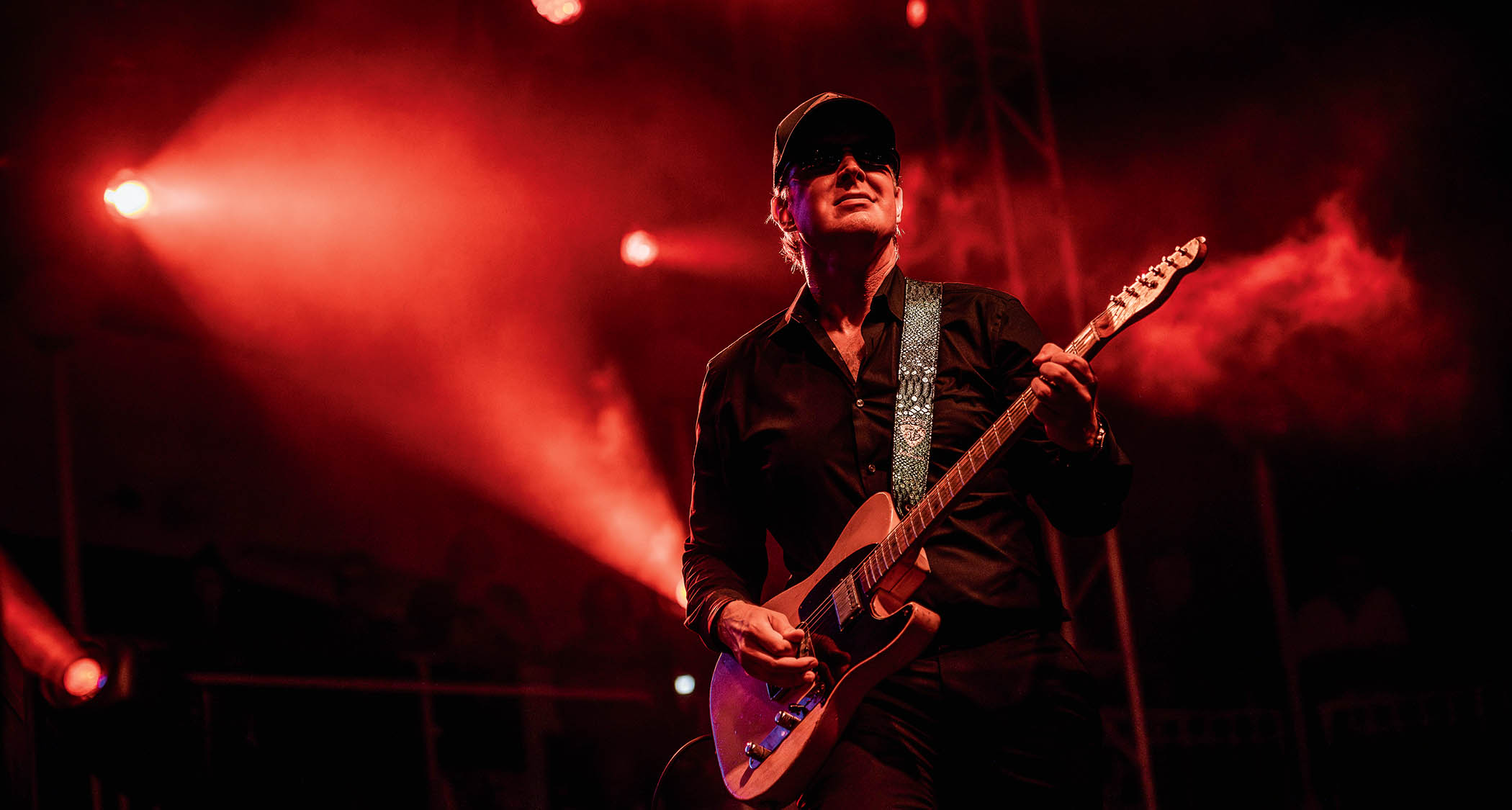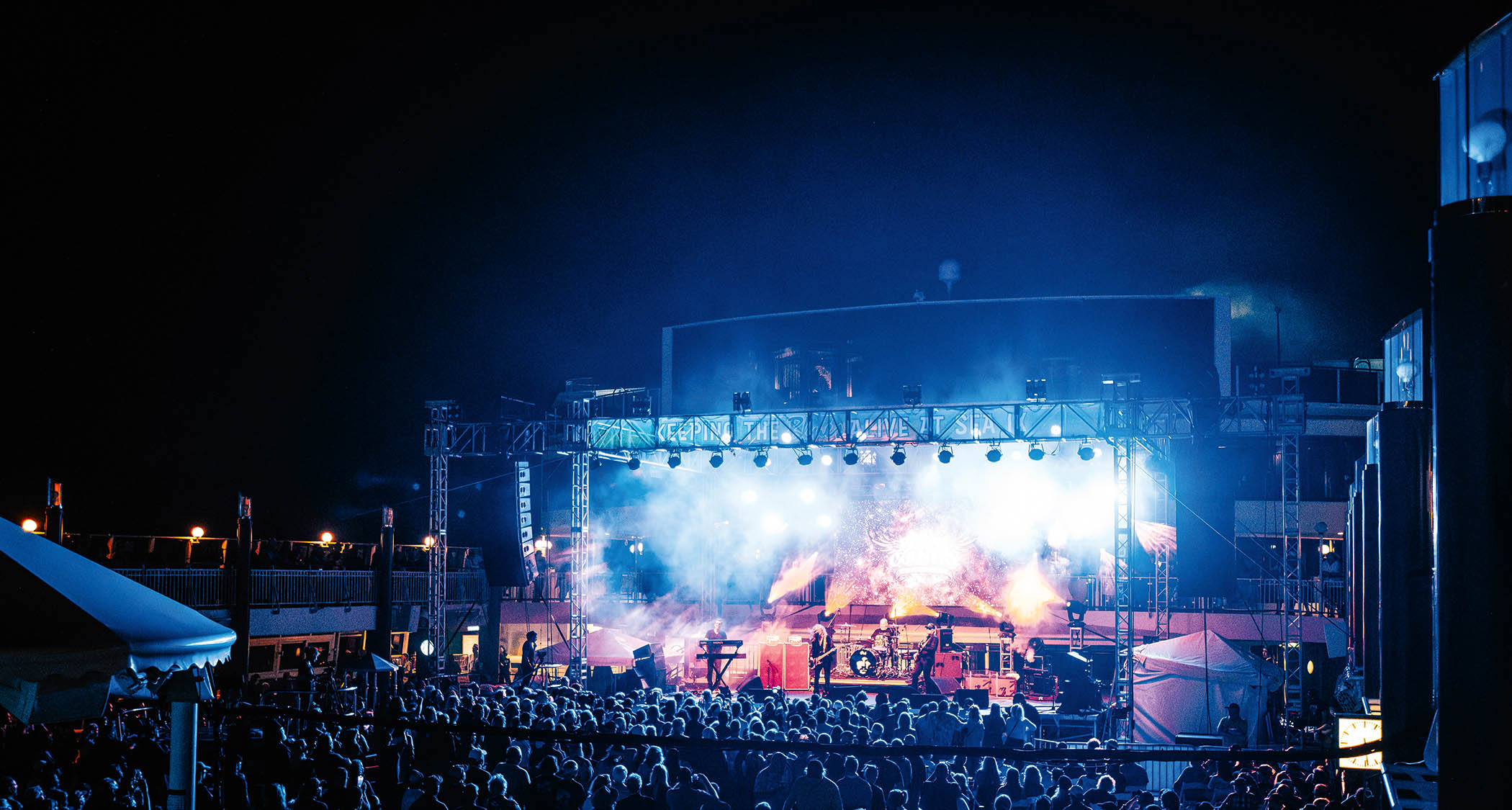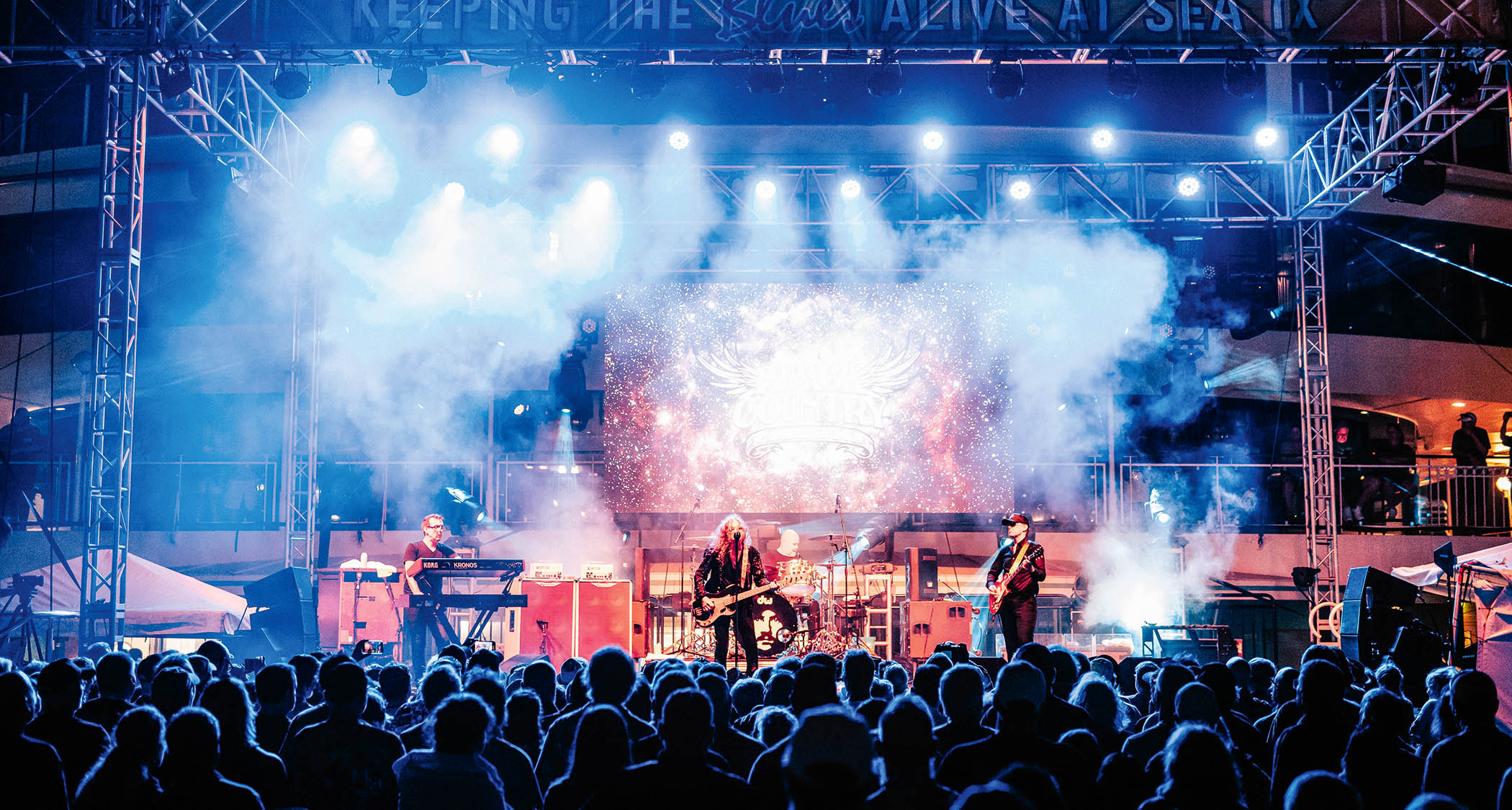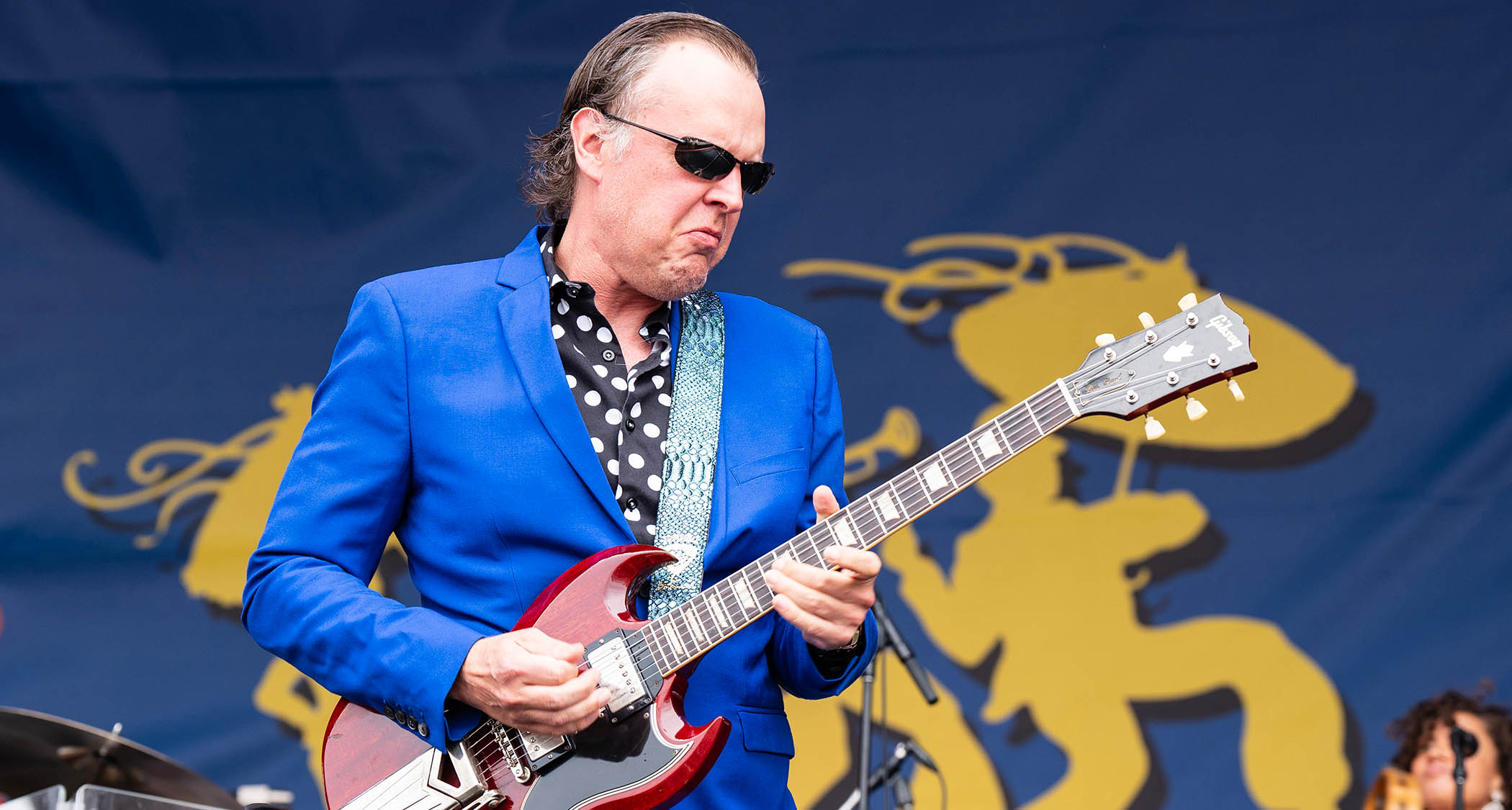“Do I get advantages that other collectors don’t? Absolutely! But I just got a 1959 Les Paul from a music store in Boston. Anybody could have walked in and bought it”: Joe Bonamassa on why he’s no ’Burst hog – and putting on his “British hat” with BCC
Joe Bonamassa checks in to tell us what it’s like to playing in rock supergroup Black Country Communion, why his rig is bigger for his solo shows, and channeling Andy Summers

Joe Bonamassa is living every rock guitarist’s dream by playing in Black Country Communion. Alongside him in this supergroup are musicians of the highest pedigree: bassist and lead vocalist Glenn Hughes (formerly of Deep and Purple and Black Sabbath), keyboard player Derek Sherinian (ex-Dream Theater) and drummer Jason Bonham, who performed in place of his late father John when Led Zeppelin played live for the final time in 2007.
On the day that Joe speaks to Total Guitar about the new Black Country Communion album – their fifth, titled simply V – he has just completed a two-night stand with his solo band at London’s prestigious Royal Albert Hall, where many of us in attendance felt he sounded better than ever.
“We were happy with the shows,” he says. “I’m lucky to call that room my home base for London. Every time you play there it gets a little easier but never gets old. It’s a special place. There’s a reason why people like going there. And the band I have playing with are all badasses… ain’t a slouch among ’em!”
You won’t find any slouches in Black Country Communion, either. And for Joe, one of the finest blues players of modern times, this group opens up a different side to his creativity, where he embraces a harder-hitting kind of rock force. The results, as per recordings of the past, are truly thunderous.
“It’s the cast of characters that dictates how the music comes out and where it goes,” he says. “Working with this band makes me play a certain way. I get to be a rock guitar player! I’m not just thinking about how I can keep my ideas in the blues. It’s amazing to be in a band with people who were actually there when rock music was evolving.
I’m a different musician in this band than when I’m going solo... Oddly enough, I use a bigger rig when I’m with my solo group, but my tone is more rock ’n’ roll with the rock band
“Glenn is a bona fide rock star. Jason has actually played with Led Zeppelin. Derek was a member of Dream Theater. I’m a different musician in this band than when I’m going solo. I know this because after we did two BCC shows a few weeks ago, I went straight into touring with my own band. Oddly enough, I use a bigger rig when I’m with my solo group, but my tone is more rock ’n’ roll with the rock band…”
You’ve worked with so many musicians over the years. In Black Country Communion, what exactly does Glenn Hughes bring out of you?
Get The Pick Newsletter
All the latest guitar news, interviews, lessons, reviews, deals and more, direct to your inbox!
“He’s a wonderful bass player and one of the greatest rock singers of all-time. He brings out things in me that are more spacious and heavier. We lock in super-tight and keep the riffs going to allow Glenn just to be Glenn.”
And how does the dynamic work with Jason Bonham and Derek Sherinian?
“Derek brings the colours and textures, while Jason and I are there to provide the foundation. Jason will also come up for grooves for riffs that I don’t think or Glenn won’t think of.
“We’ll hear it with a certain feel and then Jason will come in and say, ‘No, let’s do it like this!’ And it will sound much better. You’ve got to let the experts in the field do their thing.”
With this band, you tend to rely more on your Marshall Jubilees, although they’re certainly a key part of your solo rig. Has that changed at all with the new album?
“Believe it or not, this record was mainly recorded with a Marshall JTM45 running clean! I also used a Fender Vibrolux that Alexander Dumble modded into an Ultra-Phonix. That was pretty much it. I’d actually say one hundred per cent of the album were those two amps.”
Does that mean you were relying more on overdrives to get some extra crunch?
Glenn uses a lot of drive on the bass, so his tone is distorted. Derek uses a lot of drive on his organ sounds. So if I use a lot of drive, it will all sound like mush
“I listen to how everyone sets their stuff and then I do my own. Glenn uses a lot of drive on the bass, so his tone is distorted. Derek uses a lot of drive on his organ sounds. So if I use a lot of drive, it will all sound like mush. I don’t think I had the JTM45 above four and a half the whole time. It was clean.
“There was a little bit of hair on it but it wasn’t really drivey. A lot of my guitar tracks were doubled, but I don’t actually double my guitars. Kevin [Shirley, producer] just uses another take. If he likes take three, he’ll use take two or four and put that on the other side; it saves a lot of work! When you double clean guitars, they sound big and crunchy.”
There are some shimmering, chords in the verse sections of opening track Enlighten.
“Those clean chords were my Andy Summers moment. It was literally a Telecaster, my boss CE-1 chorus, an Echoplex and a two-knob compressor. You hear it and go, ‘Oh yeah, that’s the Andy Summers sound!’ We have a lot of different influences in this band.
“Obviously there’s the Zeppelin influence. There’s a Free influence, so it’s a lot of British rock. Plus the influence of the British rock players in the band, Jason and Glenn. Derek and I put on our British hats for this band. It’s a very straightforward approach. Kevin is able to wrangle all of our ideas into something coherent.”

You picked up a slide for the solo in Enlighten, with a generous helping of delays and reverbs… It definitely got wet!
“We had the legendary Sunset Sound studio [famously used by Led Zeppelin, Van Halen, Prince and The Rolling Stones] at our disposal, so it made sense to take advantage! All of that was done live. I sat down with the slide, I had an SG Special and a compressor going through the Dumble Vibrolux and Echoplex, and just tried my best to play slide.
Some records really fight you... Making this album felt joyous, inspired, the gear worked and the guitars stayed in tune
“I’ve never really played slide in this band, but this song called for it. I think we did it in just one or two takes, and it was one whole take. There was no comping… that was that. It worked well for the song. This record didn’t fight us, which is a good thing.
“Some records really fight you, because you sit there thinking, ‘Ugh, the f*cking guitar’s not staying in tune!’ Making this album felt joyous, inspired, the gear worked and the guitars stayed in tune. So we got our takes done quick. You want to bottle that energy.”
The song Stay Free has a similar vibe to Led Zeppelin’s Trampled Under Foot, and features another heavily echoed solo, with a phaser engaged during its second half…
“I think so… probably?! I’d have to go back and listen to it. I always have a bag of pedals with me. There will be a Keeley two-knob compressor, an Ibanez Phase Tone which looks like a TS-808 but it’s a phaser… Yeah, I just remembered that’s what I used. I’ll bring a Uni-Vibe, a CE-1 chorus and things like that.
I had an old Ross Graphics EQ on the Marshall at points, just to kick the mids up a little bit and tuck the highs. It’s noisy as f*ck, but who cares? It sounds good!
“I had an old Ross Graphics EQ on the Marshall at points, just to kick the mids up a little bit and tuck the highs. It’s noisy as f*ck, but who cares? It sounds good! All of the pedals were noisy, anyway. And I had a consistently reliable Echoplex. That’s all I used for the whole thing.
“If I needed more gain, I’d turn the amp up slightly. There wasn’t a Tube Screamer or Klon in the mix, none of that got involved on this one. I remember you and I had a notorious conversation about pedals once…”
Yes, that conversation we had, when you were promoting the last BCC album in 2017, resulted in controversy after a comment you made about guitarists being over-reliant on pedals was used out of context by clickbait websites.
“It wasn’t your fault. It wasn’t my fault! It’s the f*ckin’ world we live in, sir! But as for my bag of tools, I always have enough to get in trouble. You never know when you’re going to need something. I’ll always have a slide around.
“Kevin will throw a lot of ideas at me, like on Enlighten when he said, ‘Hey man, we need an Andy Summers sound’, and I answered, ‘Okay, let me check my back pocket!’ I’ll gather up my meagre belongings, bring them into the control and see what happens. So in that situation I got my 1954 Telecaster, plugged into the Vibrolux which was set at three or four, so it was breaking up but still clean.
I turned on the Echoplex, the chorus and the compressor, hit one chord and Kevin goes, ‘That’s it!’
“I turned on the Echoplex, the chorus and the compressor, hit one chord and Kevin goes, ‘That’s it!’ And I probably said, ‘Alright then, let’s move!’ It’s really that simple. I didn’t think too hard about it. As long as the chorus was chorusy and the Echoplex was doing that slapback with the repeats, I was happy.
“The two-knob compressor is a trick I’ve learned over the last five years. Whether it be a MXR Dyna Comp or a Keeley, when I’m in the studio dialling in cleaner sounds, those pedals can really bring everything forward in the speakers. You just have to hit it a little, not a lot, and the whole thing will start blooming. It just hits the mic and the console in a different way. It’s a good little trick!”

You’re well known for high-speed pentatonic burst runs. What’s the secret – are you using the guitar pick slanting technique often discussed by YouTube guitarists like Troy Grady?
“My picking angle doesn’t vary, whether I’m playing fast or slow. I just have a very specific place I hold it, kind of deep in there. I don’t hold it right at the tip of my thumb, and my thumb is usually straight and relaxed. I find if you hold a small pick [like a Jazz III] at the very tip, you’re creating a pivot point and a break angle.
“I hold the pick where it’s comfortable, almost as if I was sitting and having a beer with you. I could hold a pick all day. I’m not trying to angle anything. As I’m not a legato player, I have to pick every note. I’m from the Al Di Meola school rather than, say, Allan Holdsworth. That’s just always been my style, you know?”

One track on this album, Restless, is probably the closest to your solo material, bringing it all down in Bb minor.
“Yeah, I would agree with you there. All of the BCC stuff is in Eb now. When we made the last album, we tuned down half a step, so it’s kinda weird because most of our catalogue is in A440 and then the more recent stuff is tuned to Eb. I’m used to being in regular tuning for my day job.
“It’s a challenge to keep the guitars in tune because they’re all set up for a certain tension. You have to use a couple of tricks to keep them in tune and feel stout. I’ll back the truss rods out just a little bit to create more tension on the neck. That way they ring and the chords feel like they stay in tune.”
The intro to Skyway is quite reminiscent of your instrumental track Django…
“Yeah! We worked all this stuff out so fast. When we went into this record, I was slightly worried Glenn and I hadn’t had enough time to hash out the tunes enough. Because we went in with, in some cases, minimal sketches. But we’d work it all out in the courtyard of Sunset Sound, go inside and after four takes we’d be done. I was like, ‘Wow, this is a really good way to do it!’ The band works well this way.”
Can you talk us through all of the guitars we’re hearing?
“There were two Les Pauls, a 1958 and a 1959. There was that 1954 Tele I mentioned, plus a really good rosewood slab board 1959 Strat that had been refretted and sounded great for these tracks. It was four electrics in total and an acoustic – a Gibson J-200.”
Speaking of 1954 Teles, there’s one you recently picked up with a Fender-installed Paul Bigsby pickup, which you described as a ‘unicorn’.
“I haven’t even seen that guitar in person at this stage. It’s at my friend Charlie Daughty’s house in Houston. He just picked it up and said it’s f*ckin’ great! Charlie [who runs the Les Paul and Fender Forums] and I split a few guitars here and there. It eases the pain and suffering slightly, we own them jointly.
“He’s got the green Strat now, plus Lazarus and a few other things. It’s usually like, ‘I’ll send you this, I’ll send you that, blah blah!’ The 1954 Tele you hear on the record is something I bought from Norman Harris [Norman’s Rare Guitars] right before he became ill in 2021.
“I just happened to be at the store and he said to me, ‘Man, if I can make a little money on this, I’ll introduce you to the family’. I literally bought it that day. It’s my go-to blackguard Tele for LA. It just works, it sounds great and plays great. It’s a guitar that can do anything.”
As for the newest one, Fender installing a Bigsby pickup… that’s pretty unheard of!
“The guy bought it in 1954 and it went back to the Fender factory for the pickup install. If you look at the route, it was clearly done by a machine. So they jammed it in there for him.
“Fender would do warranty like that back then if you waited. The guy wrote a letter about the whole story behind it. Somebody tipped me off saying this guitar was discussed on an Internet forum 20 years ago.
“It’s pretty well-known in the Telecaster community, but not many people knew where it ended up. It recently came up for sale through the family. The guy died, he was 99 years old. Having the pictures and story behind it is pretty cool… and that pickup is even rarer than the guitar!”

You purchased another 59 recently – serial number 9-0435, to be more specific – which came in a blue-lined case. What was the story behind that one?
“It belonged to my friend Joe Martino, who I met through Norman back in 2021. Joe was very astute in the late ’70s and early ’80s. He paid $1,700 to this little boutique amp maker out in Santa Cruz, California. That guy’s name was Alexander Dumble! He got an Overdrive Special, that’s how I met him, I bought his 50-watt Silverface ODS.
A lot of times these bursts have traded hands so many times it leaves you wondering, ‘What’s been done to this guitar?’
“Long story short, in 1982 he bought a 1959 Les Paul Standard and another ODS. He paid $2,000 for the Les Paul and $2,500 for the amp. He was telling me people were making fun of him because of how much he spent on the guitar but he freakin’ held it! That guitar ended up at a music store outside of Boston called The Music Emporium.
“I kinda lost track of where it went, but figured they had it. So I contacted the store and they said, ‘Yeah man, let’s boogie!’ So the guitar hasn’t left the Boston area since 1982. It’s still actually there, my tech Mike [Hickey] has it at the moment. It’s a very cool guitar that I’ve played before.
“It has factory small frets but I like the story behind the guitar because I know the CarFact. A lot of times these bursts have traded hands so many times it leaves you wondering, ‘What’s been done to this guitar?’ This one is just a straight original.”
Another one for the collection, then. How many ’59s does that bring you to now, considering they made roughly 500 that year?
“They shipped 536 or 539 in 1959. Les Paul Standards from 1958 were split between goldtops and bursts. So the rarest variant is the ’58 burst, because they were only made for half the year. I have a 1960 SG Les Paul Standard and the serial number is lower than one of my late-’60s sunbursts one.
“They were shipping them tangentially as they would roll out. There are approximately 1,700 guitars shipping between 1958 and 1960. So they’re not incredibly rare, just incredibly sought-after. I own 16 ’bursts in total, from 1958 to 1960, and I own eight 1959s.”

It’s great that you share these guitar safaris with us. We get to live vicariously through you – and there’s a lot to be said for celebrating history, especially through your eye for detail.
“That’s the way I look at it. There’s a contingent of people who somehow think I’m depriving the world and other players of gear. I always use the logic, ‘Do I get advantages that other collectors don’t because people want to sell sh*t to me? Absolutely!’ But I also just bought a 1959 Les Paul from a f*ckin’ music store in Boston. Anybody could have walked in and bought it.
I also just bought a 1959 Les Paul from a f*ckin’ music store in Boston. Anybody could have walked in and bought it
“There are thousands and thousands of guitars out there. Anything in my collection, with the exception of maybe 20 pieces, you could source from somewhere else. You want a Blackguard? There’s plenty of them. You want a sunburst Les Paul? There’s plenty of them. You want a 335 in a blonde finish. There’s not so many of those, but if you want them in sunburst, there’s a lot out there.”
And as your collection expands, there’s a mid-’60s Strat you recently got your hands on in Sonic Blue…
“Now, that’s a hard colour to find pre-1965. Mine’s actually [from] December 1963, so it’s got the right neck and the black bottoms. In late 1964 and 1965 they had the transitional logos, and then later ones with bigger headstocks. That’s the first two years of the custom colour charts.
“Sonic Blue is not as rare as Foam Green or Burgundy Mist. There are a couple that are really hard to find. Shell Pink is unobtainium, there are only one or two known examples. Fiesta [Red] is the most common. Lake Placid is common, as is Black and Candy Apple Red, so getting the chance to buy an uncirculated Sonic Blue Strat was cool!”
- V is out now via Ingrooves.
Amit has been writing for titles like Total Guitar, MusicRadar and Guitar World for over a decade and counts Richie Kotzen, Guthrie Govan and Jeff Beck among his primary influences as a guitar player. He's worked for magazines like Kerrang!, Metal Hammer, Classic Rock, Prog, Record Collector, Planet Rock, Rhythm and Bass Player, as well as newspapers like Metro and The Independent, interviewing everyone from Ozzy Osbourne and Lemmy to Slash and Jimmy Page, and once even traded solos with a member of Slayer on a track released internationally. As a session guitarist, he's played alongside members of Judas Priest and Uriah Heep in London ensemble Metalworks, as well as handled lead guitars for legends like Glen Matlock (Sex Pistols, The Faces) and Stu Hamm (Steve Vai, Joe Satriani, G3).















![[from left] George Harrison with his Gretsch Country Gentleman, Norman Harris of Norman's Rare Guitars holds a gold-top Les Paul, John Fogerty with his legendary 1969 Rickenbacker](https://cdn.mos.cms.futurecdn.net/TuH3nuhn9etqjdn5sy4ntW.jpg)





